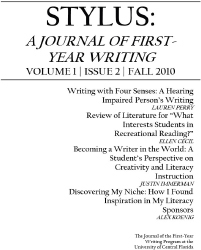Getting Ready to Read
Getting Ready to Read
Before you read, do the following activity:
- Do a little research about American Sign Language (ASL) and various educational opportunities for children with hearing impairment.
As you read, consider the following questions:
- What is surprising to you? Are there questions and influences on writing Perry explores that you had not considered before?
1
Fifty-one million people out of a total estimated population of 300 million in the United States have a disability. Within that 51 million, about one million have some sort of hearing impairment; this is one million people that may or may not have a fully developed literacy due to their impairment (U.S Census Bureau). I am one out of that million people. I have severe hearing loss in my left ear and moderate hearing loss in my right ear. I am obviously not of normal hearing, but I do not exactly fall into the deaf category either. Since I reside somewhere in between the two extremes, I have come to believe that hearing impairment—mild to severe—affects a person’s writing development.

2
Hearing impairment affects a person’s writing in various areas. Research has identified some of these areas, such as grammar errors, syntax, writing strategies, and others (Antia, Reed, and Kreimeyer; Marschark and Spencer; Mayer; Paul; Yashinago-Itano, Snyder, and Mayberry). Even though researchers may stress different points, this is not to say that some areas are more important than others. Researchers have studied different areas of writing in hearing impaired students of a specific age or span of age levels, but there has not been research on the consistency of the problem areas over a length of time. As a result, it must be determined if, after progressing through school, hearing impaired students still show the same writing errors related to their hearing impairment.